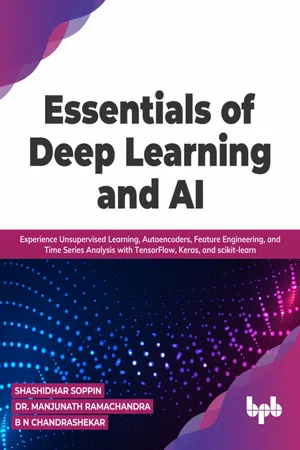
Essentials of Deep Learning and AI
Experience Unsupervised Learning, Autoencoders, Feature Engineering, and Time Series Analysis with TensorFlow, Keras, and scikit-learn
Shashidhar Soppin , B N Chandrashekar, Dr. Manjunath Ramachandra
- English
- ePUB (handyfreundlich)
- Über iOS und Android verfügbar
Essentials of Deep Learning and AI
Experience Unsupervised Learning, Autoencoders, Feature Engineering, and Time Series Analysis with TensorFlow, Keras, and scikit-learn
Shashidhar Soppin , B N Chandrashekar, Dr. Manjunath Ramachandra
Über dieses Buch
Drives next generation path with latest design techniques and methods in the fields of AI and Deep Learning
Key Features
? Extensive examples of Machine Learning and Deep Learning principles.
? Includes graphical demonstrations and visual tutorials for various libraries, configurations, and settings.
? Numerous use cases with the code snippets and examples are presented.
Description
'Essentials of Deep Learning and AI' curates the essential knowledge of working on deep neural network techniques and advanced machine learning concepts. This book is for those who want to know more about how deep neural networks work and advanced machine learning principles including real-world examples.This book includes implemented code snippets and step-by-step instructions for how to use them. You'll be amazed at how SciKit-Learn, Keras, and TensorFlow are used in AI applications to speed up the learning process and produce superior results. With the help of detailed examples and code templates, you'll be running your scripts in no time. You will practice constructing models and optimise performance while working in an AI environment.Readers will be able to start writing their programmes with confidence and ease. Experts and newcomers alike will have access to advanced methodologies. For easier reading, concept explanations are presented straightforwardly, with all relevant facts included.
What you will learn
? Learn feature engineering using a variety of autoencoders, CNNs, and LSTMs.
? Get to explore Time Series, Computer Vision and NLP models with insightful examples.
? Dive deeper into Activation and Loss functions with various scenarios.
? Get the experience of Deep Learning and AI across IoT, Telecom, and Health Care.
? Build a strong foundation around AI, ML and Deep Learning principles and key concepts.
Who this book is for
This book targets Machine Learning Engineers, Data Scientists, Data Engineers, Business Intelligence Analysts, and Software Developers who wish to gain a firm grasp on the fundamentals of Deep Learning and Artificial Intelligence. Readers should have a working knowledge of computer programming concepts.
Table of Contents
1. Introduction
2. Supervised Machine Learning
3. System Analysis with Machine Learning/Un-Supervised Learning
4. Feature Engineering
5. Classification, Clustering, Association Rules, and Regression
6. Time Series Analysis
7. Data Cleanup, Characteristics and Feature Selection
8. Ensemble Model Development
9. Design with Deep Learning
10. Design with Multi Layered Perceptron (MLP)
11. Long Short Term Memory Networks
12. Autoencoders
13. Applications of Machine Learning and Deep Learning
14. Emerging and Future Technologies.
Häufig gestellte Fragen
Information
CHAPTER 1
Introduction
Structure
- Artificial intelligence
- What is Artificial Intelligence?
- Definitions of AI
- Applications of AI
- Use cases of AI
- Broad classification of what is AI, ML, FL, and DL?
- Machine learning
- History and definitions of ML
- ML and its applications
- Classification of ML algorithms
- Deep Learning
- Prerequisite to understand deep learning
- Difference between machine learning & deep learning
- Tools and frameworks for AI, ML, and DL
- Languages used for AI, ML, and DL
- Datasets for AI, ML, and DL development
Objectives
- Understand the concepts of AI, ML, DL and their components
- History of AI, ML, and DL
- Defined AI, ML, DL along with some examples and applications
- Benefits of using AI, ML, and DL in overall
- Programming languages used for ML & DL
- Standard tools used for ML & DL
- Reference database used for model development
1.1 Artificial intelligence
1.1.1 What is Artificial Intelligence?
1.1.2 Definitions of Artificial Intelligence
| Index | Year | AI definition | Defined By | Ref: Link |
| 1 | 1950 | Alan Turing didn't define what is AI. But while carrying out the so popularly called "The Turing Test" he came up with the question "whether machines can think?" | Alan Turing | https://plato.stanford.edu/entries/turing-test/ https://www.csee.umbc.edu/courses/471/papers/turing.pdf |
| 2 | 1978 | “The automation of activities that we associate with human thinking, activities such as decision-making problem-solving learning” | Bellman | https://archive.org/details/ AnIntroductionToArtificialIntelligence/page /n11/mode/2up |
| 3 | 1985 | “The exciting new effort to make computers think…machines with minds, in the full and literal sense.” | Haugeland | https://mitpress.mit.edu/books/artificial-intelligence-1 |
| 4 | 1985 | “The study of mental faculties through the use of computational models” | Charniak &McDermott | https://dl.acm.org/doi/book/10.5555/30426 |
| 5 | 1990 | “The art of creating machines that perform functions that require intelligence when performed by people” | Kurzweil | |
| 6 | 1992 | “The study of the computations that make it possible to perceive, reason and act” | Winston | |
| 7 | 1998 | “Computational Intelligence is the study of the design intelligent agents” “AI….is concerned with intelligent behavior in artifacts” | Poole et.al Nilsson |
1.1.3 Applications of Artificial Intelligence
Inhaltsverzeichnis
- Cover Page
- Title Page
- Copyright Page
- Foreword
- Dedication Page
- About the Authors
- About the Reviewer
- Acknowledgement
- Preface
- Errata
- Table of Contents
- 1. Introduction
- 2. Supervised Machine Learning
- 3. System Analysis with Machine Learning/Un-Supervised Learning
- 4. Feature Engineering
- 5. Classification, Clustering, Association Rules, and Regression
- 6. Time Series Analysis
- 7. Data Cleanup, Characteristics and Feature Selection
- 8. Ensemble Model Development
- 9. Design with Deep Learning
- 10. Design with Multi Layered Perceptron (MLP)
- 11. Long Short Term Memory Networks
- 12. Autoencoders
- 13. Applications of Machine Learning and Deep Learning
- 14. Emerging and Future Technologies
- Index